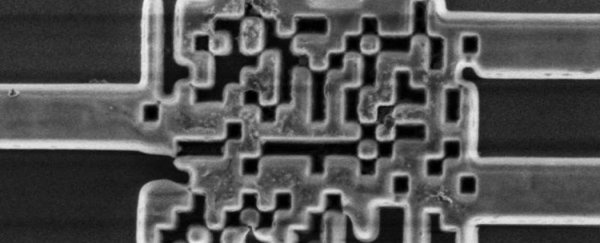The smallest ever 'ultracompact polarisation beamsplitter' - a component used in silicon photonic chips - has been developed by engineers in the US, and because of its ability to deliver information via two separate light waves, the device points to a new generation of computers that can transmit information at the speed of light.
"Light is the fastest thing you can use to transmit information," one of the team, Rajesh Menon from the University of Utah, said in press release. "But that information has to be converted to electrons when it comes into your laptop. In that conversion, you're slowing things down. The vision is to do everything in light."
Over the past decade or so, we've ditched the old model of transmitting information via copper wires and electrons, and we now communicate with each other via underwater optical fibres that transmit light particles - or photons - between almost every continent on Earth. But there's a problem: these optical fibres still have to work with existing electronic computer chips, which means once information is delivered to your computer or router in photon form, it has to be converted into the slower electron form in order to be processed, which slows everything down.
For this reason, scientists around the world have been working towards taking the functionality of an electronic chip and putting it in a new type of silicon photonic chip. That means no conversion process to slow everything down, so information will be transferred WAY faster than it is right now, and computer processing speeds would skyrocket. That means less power required, and longer battery life. "With all light, computing can eventually be millions of times faster," Menon said.
Menon and his team figured out how to take current beamsplitters, which are about 100 by 100 microns in size, and shrink them down to a mind-boggling 2.4 by 2.4 microns. That's one-50th the width of a human hair, and pretty close to the limit when it comes to producing tiny physical objects. When placed on a silicon chip, they were still able to perform their most important function - splitting guided light beams into the chip's two components.
By cutting down the size of these tiny components so much, Melon and his team have paved the way for a single silicon photonic chip to be loaded with millions of them, which is what needs to happen in order for them to rival existing electronic chips.
And all of this isn't so far off. "The first supercomputers using silicon photonics - already under development at companies such as Intel and IBM - will use hybrid processors that remain partly electronic," the press release explains. "Menon believes his beamsplitter could be used in those computers in about three years. Data centres that require faster connections between computers also could implement the technology soon, he says."
Streaming Netflix at light-speed? Can't wait to never leave the house again.
The research has been published in Nature Photonics.
